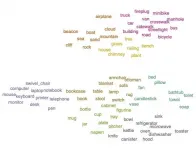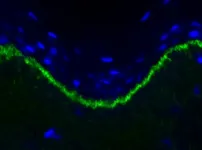Team find brain mechanism that automatically links objects in our minds
2021-07-08
(Press-News.org) When people see a toothbrush, a car, a tree -- any individual object -- their brain automatically associates it with other things it naturally occurs with, allowing humans to build context for their surroundings and set expectations for the world.
By using machine-learning and brain imaging, researchers measured the extent of the "co-occurrence" phenomenon and identified the brain region involved. The findings appear in Nature Communications.
"When we see a refrigerator, we think we're just looking at a refrigerator, but in our mind, we're also calling up all the other things in a kitchen that we associate with a refrigerator," said corresponding author Mick Bonner, a Johns Hopkins University cognitive scientist. "This is the first time anyone has quantified this and identified the brain region where it happens."
In a two-part study, Bonner and co-author, Russell Epstein, a psychology professor at the University of Pennsylvania, used a database with thousands of scenic photos with every object labeled. There were pictures of household scenes, city life, nature -- and the pictures had labels for every mug, car, tree, etc. To quantify object co-occurrences, or how often certain objects appeared with others, they created a statistical model and algorithm that demonstrated the likelihood of seeing a pen if you saw a keyboard, or seeing a boat if you saw a dishwasher.
With these contextual associations quantified, the researchers next attempted to map the brain region that handles the links.
While subjects were having their brain activity monitored with functional magnetic resonance imaging, or fMRI, the team showed them pictures of individual objects and looked for evidence of a region whose responses tracked this co-occurrence information. The spot they identified was a region in the visual cortex commonly associated with the processing of spatial scenes.
"When you look at a plane, this region signals sky and clouds and all the other things," Bonner said. "This region of the brain long thought to process the spatial environment is also coding information about what things go together in the world."
Researchers have long-known that people are slower to recognize objects out of context. The team believes this is the first large-scale experiment to quantify the associations between objects in the visual environment as well as the first insight into how this visual context is represented in the brain.
"We show in a fine-grained way that the brain actually seems to represent this rich statistical information," Bonner said.
INFORMATION:
[Attachments] See images for this press release:

ELSE PRESS RELEASES FROM THIS DATE:
2021-07-08
A team of the University of Barcelona has analysed for the first time what the dry and hot periods could be like in the area of the Pyrenees depending on different greenhouse emission scenarios. The results, published in the journal Natural Hazards and Earth System Sciences, show that under an intermediate scenario, where these emissions that accelerate the climate change could be limited, there would not be a rise in long-lasting dry episodes, but temperatures would rise during these periods. On the other hand, if those emissions were not reduced during the 21st century, the summer no-rain periods would last an average ...
2021-07-08
In a new study assessing the potential of a single-dose, intranasal COVID-19 vaccine, a team from the University of Iowa and the University of Georgia found that the vaccine fully protects mice against lethal COVID-19 infection. The vaccine also blocks animal-to-animal transmission of the virus. The findings were published July 2 in the journal Science Advances.
"The currently available vaccines against COVID-19 are very successful, but the majority of the world's population is still unvaccinated and there is a critical need for more vaccines that are easy to use and effective at stopping disease and transmission," says Paul McCray, MD, professor of pediatrics-pulmonary medicine, and microbiology and immunology ...
2021-07-08
Philadelphia, July 8, 2021 - Fifty-five percent of Midwest university students had tried a plant-based meat alternative and attributed this choice to the enjoyment of new food, curiosity about the products, and environmental concern, according to a new study in the Journal of Nutrition Education and Behavior, published by Elsevier.
For several decades, there has been a steady growth in consumer concerns about the environmental sustainability of the global food supply, animal welfare ethics, and human health consequences of red meat intakes. To assess the prevalence of plant-based alternatives to meat consumption in students; describe associations between demographics, environmental concern attitudes, and consumption; ...
2021-07-08
A new study has linked a July 2015 ceasefire of conflict violence in Colombia with better pregnancy outcomes for women who conceived after the ceasefire began. Giancarlo Buitrago of Universidad Nacional de Colombia in Bogotá, Colombia, and Rodrigo Moreno-Serra of the University of York, U.K., present these findings in the open-access journal PLOS Medicine.
Previous research has suggested the possibility that women living in areas with armed violence experience adverse pregnancy outcomes. However, methodological problems or inappropriate data have hampered prior investigations into these associations.
To better understand these associations, Buitrago and Moreno-Serra examined pregnancy outcome data for women who conceived before and after a ceasefire of conflict violence was declared ...
2021-07-08
Scientists at the University of Groningen have trained an Artificial Intelligence system to recognize a specific pattern in skin biopsies of patients with the blistering disease epidermolysis bullosa acquisita. The pattern is characteristic of a specific variant of the disease which can cause scarring of the skin and mucous membranes and may lead to blindness. The new system is easy to use and is better than most doctors in making the diagnosis. A description of this AI system is published in the American Journal of Pathology.
In patients with epidermolysis bullosa, layers of the skin get detached, causing large blisters. There are different forms of blistering diseases affecting different layers ...
2021-07-08
Thyroid hormones are amino acid-based molecules produced by the thyroid gland. Involved in direct or indirect regulation of key metabolic pathways, these molecules play critical roles in the development and normal functioning of the body. The mechanism of how thyroid hormones exert their effect on each other as well as on other metabolic pathways is complex, but a two-way feedback loop is central to their biological activity. Dysregulation of the feedback loop that controls their production affects other biochemical pathways, causing various ailments including those related to the cardiovascular system, liver function, or bone development.
Several clinical studies have shown the effect of thyroid hormones on lipid levels: that treating the patients with thyroid hormone analogs helps ...
2021-07-08
As luck would have it, the air quality sensors that University of Utah researcher Daniel Mendoza and his colleagues installed in Park City, Utah in September 2019, hoping to observe how pollution rose and fell through the ski season and the Sundance Film Festival, captured a far more impactful natural experiment: the COVID-19 pandemic.
Throughout the pandemic, the air sensors watched during lockdowns as air pollution fell in residential and commercial areas, and then as pollution rose again with reopenings. The changing levels, the researchers found, which behaved differently in residential and commercial parts of the city, show where pollution is coming from and how it might change in the future under different policies.
"The lockdown period demonstrated ...
2021-07-08
UNIVERSITY PARK, Pa. -- When it comes to what users share on Twitter, women and users who never attended college voluntarily disclose more personal information than users from other socioeconomic and demographic backgrounds -- potentially making these populations more susceptible to online privacy threats, according to a recent study led by the Penn State College of Information Sciences and Technology.
Additionally, the researchers unexpectedly found that neither socioeconomic status nor demographics is a significant predictor of the use of account security features such as two-factor login authentication, and that users from all backgrounds actually ...
2021-07-08
URBANA, Ill. - If you've ever been to an eye doctor, there's a good chance you've felt the sudden puff of air to the eye that constitutes a traditional test for glaucoma. It's no one's favorite experience, but the puff is non-invasive and harmless.
Scientists use a similar method to test learning and memory in animals and humans. Like Pavlov's classic experiments linking a neutral stimulus with a physiological response, the eyeblink test pairs a light or sound with a quick puff of air to the eye. With repetition, the animal learns to close its eye, or blink, in response ...
2021-07-08
Researchers from the University of Sussex have determined the structure of a tiny multi-protein biological machine, furthering our understanding of human cells and helping to enhance research into cancer, neurodegeneration and other illnesses.
A biological nanomachine is a macromolecular machine commonly found within the cell, often in the form of multi-protein complexes, which frequently perform tasks essential for life.
The nanomachine R2TP-TTT acts as a molecular chaperone to assemble others in the human cell. It is especially important for constructing mTORC1 - a complicated nanomachine that regulates the cell's energy metabolism, and which often becomes misregulated in human diseases such as cancer and diabetes.
Scientists from the School ...
LAST 30 PRESS RELEASES:
[Press-News.org] Team find brain mechanism that automatically links objects in our minds



